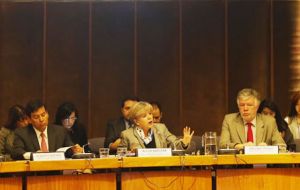MercoPress. South Atlantic News Agency
Latam's low indebtedness level opens the way for anti-cyclical fiscal policies to spur economies, says ECLAC
 ECLAC recommends a higher share of direct over indirect taxation and urged countries to “continue taking action to fight fiscal evasion and circumvention”
ECLAC recommends a higher share of direct over indirect taxation and urged countries to “continue taking action to fight fiscal evasion and circumvention” Latin America's public debt decreased in the last 25 years, according to a report from the Economic Commission for Latin America and the Caribbean (ECLAC). External public debt fell from 70% to 16% of the region’s GDP highlighted the fiscal analysis of the region, rising to near 40% when domestic public debt is added to calculations.
The “Fiscal Panorama” of the region said this opens an opportunity for public investment in infrastructure projects to increase the region’s productivity, even if resources were expected to decrease in the coming years, as the price of commodities exported by it are undergoing a decline.
“Taking a long-term view with regard to the proportion of public debt versus GDP, Latin America (considering the average of 19 countries) experienced a long period of rising debt levels (1970-1989), followed by phases in which they fell (1990-1997 and 2004-2008, after a brief period of increases between 1998 and 2003), and they ultimately stabilized between 2009 and 2014,” the ECLAC said.
The period of rising debt levels was known in academic circles as the years of “Latin America’s debt crisis,” whose peak came after the region’s countries and private companies changed their indebtedness policies in the 1970s by taking large amounts of “petro-dollars” on loan but struggled to pay them back when the large amount of capital inflows suddenly dried up.
This was followed by a period of slow growth in the 80s, which meant that the region came out of that decade with debt around 70% of GDP, improving until the end of the 1990s, when problems resurfaced.
According to ECLAC, “between 2003 and 2008, the level of public debt fell considerably and its composition also changed in a significant way, with longer maturities, greater participation of fixed-rate debt, a greater proportion of resident debt-holders and the growing importance of debt denominated in the local currency.”
This has reduced debt-related risk which countries face, although levels vary widely across countries.
South America’s biggest country is also its most indebted; as Brazil owes creditors 63.5% of GDP when debt held inside its borders is included. Argentina is seen as having “moderate” debt levels, at 40% of its GDP, down from nearly 45% in 2000. Those levels are similar to Uruguay, Colombia, Mexico, Costa Rica and Honduras, all between 36% and 44% of GDP.
The lowest debt levels, below 22% of GDP, were shown by Chile, Peru and Paraguay.
The report said this was achieved largely thanks to an increase in the tax burden imposed by states, which rose 5 points of GDP since the turn of the century across the continent.
But a structure of “regressive taxes” was responsible for this fiscal improvement, which meant income redistribution through taxation was not significant.
ECLAC recommended a higher share of direct taxation (such as income taxes) over indirect taxation (such as value-added tax), adding that it was urging countries to “continue taking action to fight fiscal evasion and circumvention, reduce preferential treatment and generally strengthen taxation on capital gains.”
The UN-backed institution was critical of some of the continent’s fiscal policies, including its management of non-renewable natural resources, calling for policies to make the country’s fiscal health less dependent on the international variation of commodity prices, on which local authorities don’t exert a strong influence.
Tax policies, ECLAC argued, needed to focus on reducing volatility and increasing equality on a sustainable basis.
The report’s main conclusion said the region’s low indebtedness levels opened the door for anti-cyclical fiscal policies to jumpstart depressed economic growth, while also improving productivity if those resources were used efficiently for key infrastructure projects.
“Projects financed with public or public-private resources can increase economic activity, especially when the economy is going through a period of idle capacity and when infrastructure investment needs are clearly identified, which is true of the region today,” the report concluded.




Top Comments
Disclaimer & comment rules-

-

-

Read all commentshaha!
Mar 11th, 2015 - 07:52 am 0Lot's of overly-clever and psuedo-sophisticated 'business-jargon' designed to fool the unaware.
In real-terms, there are opportunities for the risk-aware within Lat-Am,
'not for widows or orphans', but possibilities for entrepreneuers with money to lose'...
They have been saying the same for so many years...
I have both won, and lost, money there.
Nothing really changes.
:-/
I just love the headline 16% rate, except it isn't when you add the domestic public debt and then it's 40%
Mar 11th, 2015 - 11:09 am 0Does anybody even listen to these cretins?
I GUESS THAT YOU DONT GET IT THE ECONOMICAL DEVELOPMENT , 1 ILSEN , PLEASEE STOP SPITTING CRAP IF YOU DONT UNDERSTAND BASIC ECONOMY OR YOU GOT NOTHING TO DO , PAL??, DIDNT YOU KNOW THAT DURING RECEPTION OR BAD ECONOMIC TIME MANY PEOPLE MAKE MONEY OUT OF IT>> /?? DUMB APE IGNORANT. http://www.fdrurl.com/uk, http://www.fdrurl.com/uk, , htpp://www.moneyweek.com/endofbritain
Mar 13th, 2015 - 08:16 am 0Commenting for this story is now closed.
If you have a Facebook account, become a fan and comment on our Facebook Page!